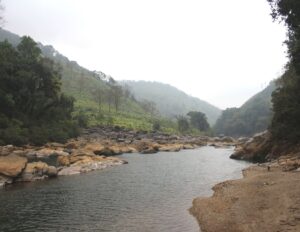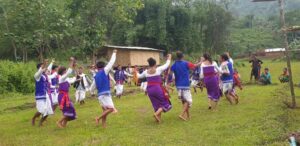Written by Sachin Kumar
The community faced a growing concern in the beautiful village of Khweng, situated in the hills of Ri-Bhoi district. Nearly all of their ancestral lands had been transformed into private property, leading to unforeseen consequences. The lifeblood of the village, its water sources, was at risk. This prompted the community members to embark on an extraordinary journey to reclaim their water catchment areas and ensure the sustenance of their future generations.
The community members of Khweng had already experienced the dire effects of privatization. Their two crucial catchment areas, Wah Lasubon and Wah Umsyiem, vital for water supply to the entire village, were now under private ownership. Without control over these water sources, the community faced an uncertain future. But instead of succumbing to despair, they rallied together with a determination to reclaim what was rightfully theirs.
The village headman, Jewing Nongpoh, known for his vigor and dedication, along with the executive committee, played a pivotal role in this initiative. The women members of the village voiced their gratitude, saying, “We are grateful to the energetic Headman and the executive committee, who showed great concern for the preservation of the water resources, which are our only source of sustenance.”
To ensure long-term availability, it was imperative to manage the catchment areas properly. This wasn’t just about securing water for human consumption; it was also about sustaining agriculture and maintaining aquatic life, which provided a crucial food source for the local population. The preservation of these water sources would benefit not only the current generation but also future generations.
The idea to reclaim the land and protect the catchment areas came from the executive committee in 2014. They consulted with various stakeholders, including NESFAS, the Meghalaya Rural Development Society, and, most importantly, the community members who were directly affected by the water crisis. The process began with extensive discussions and dialogues. They highlighted several critical issues: the lack of drinking water, the inability to plant trees around the catchment areas due to private ownership, and the need for the landowner’s permission to draw water from the sources.
To overcome these challenges, the executive committee devised a strategic plan. They needed the landowner’s consent to reclaim the catchment areas. After numerous conversations and negotiations, the landowner agreed to sell the land to the village council for a certain amount. With the collective effort and financial contributions of the community, the village council purchased the land.
Following the acquisition, the community took swift action. They declared the five acres of reclaimed land as a restricted forest. This was a significant step towards conservation. The community members planted more trees around the catchment areas, enhancing the natural filtration of water and improving the overall health of the ecosystem. The village council also implemented a new water pipe distribution system to ensure that every settlement had access to clean water.
The positive outcomes of this land reclamation were manifold. The restricted forest status of the land meant that the water bodies were better protected and more sustainable. Aquatic life thrived, providing the community with a reliable source of food from the rivers and streams. The water crisis that had once plagued the village was now a thing of the past.
The village enacted an ordinance prohibiting the use of poisons to harm aquatic life. This measure ensured that the ecosystem remained healthy and that harmful substances did not compromise the water quality.
The community of Khweng demonstrated through unity and determination, a community could overcome significant challenges. By reclaiming their land and protecting their water sources, they not only secured their present needs but also laid a strong foundation for future generations. The actions of the headman, the executive committee, and the entire community exemplified the power of collective effort and the importance of preserving natural resources.



